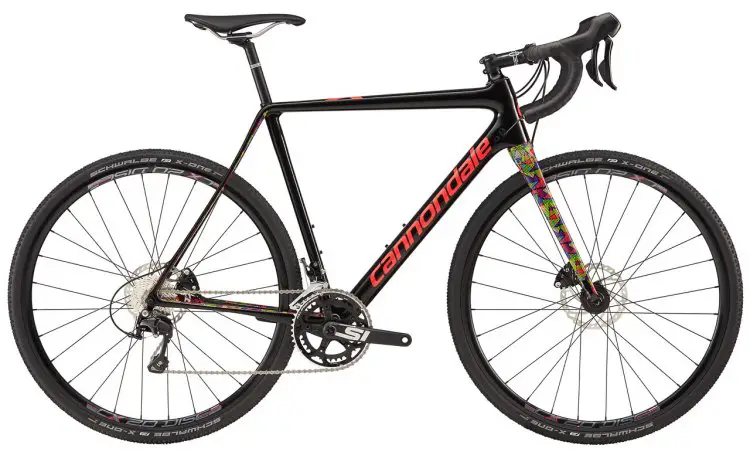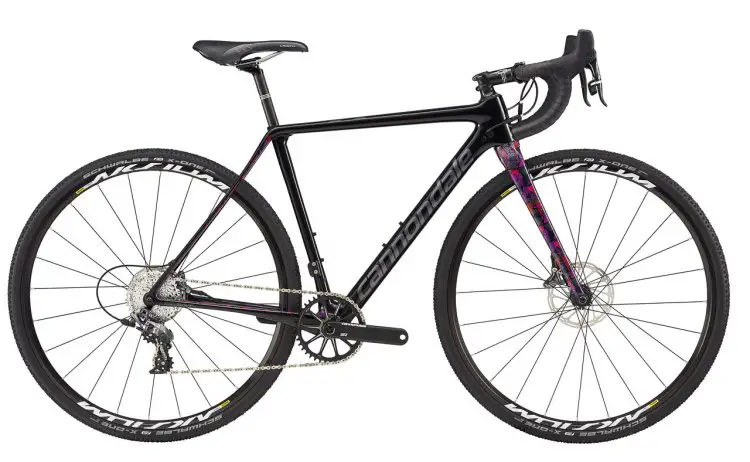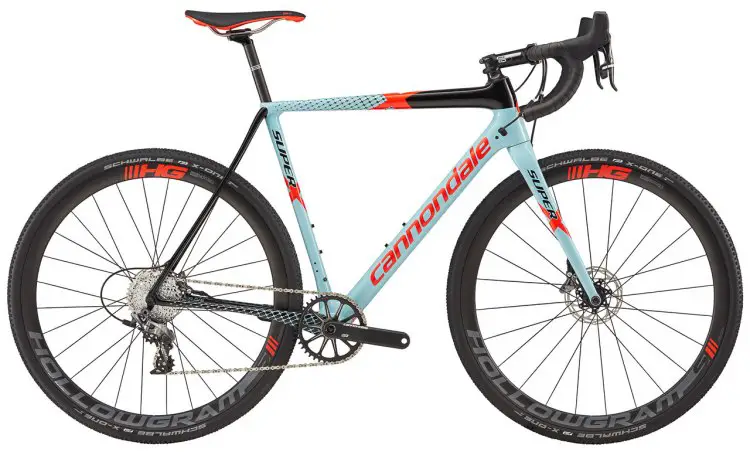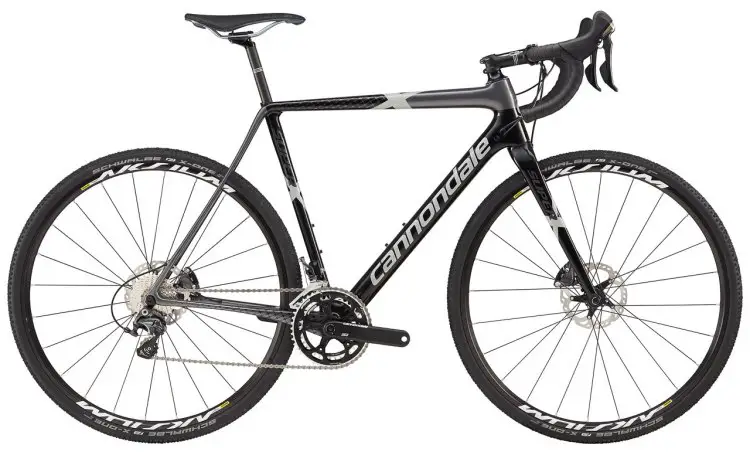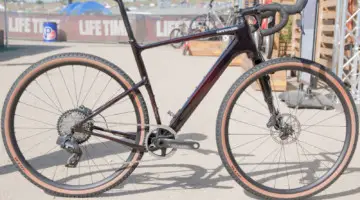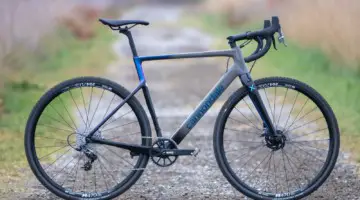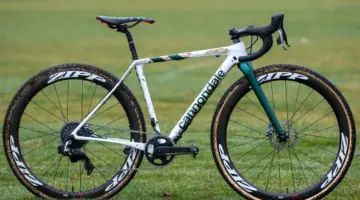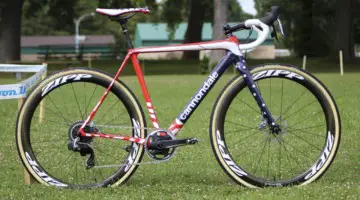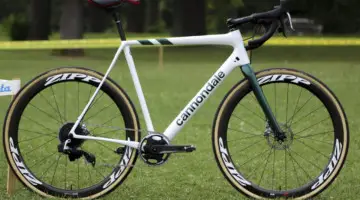For as long as we’ve been running this website and magazine, we’ve seen a gradual evolution in cyclocross race bikes. Each year, in general, there’s been more carbon, a gradual lowering of bottom bracket heights and a shortening of chainstays, a re-introduction of disc brakes and, of course, new component groups, bottom bracket shells and axle configurations.
Up front, besides adding disc brakes and thru axles, there hasn’t been much change on the 100+ bikes we’ve ridden over the years. For a 56cm bike, head tube angles have hovered around 72 degrees, fork rake at 45 to 47mm and axle-to-crown measurements around 395mm.
Cannondale Pushes Ahead
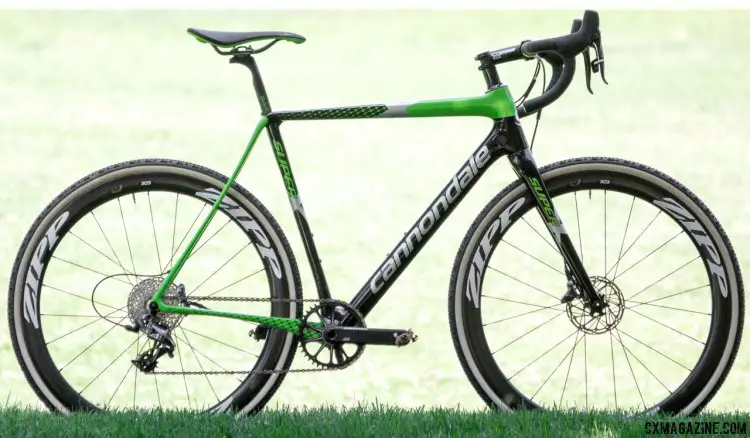
Upgrade nothing: The 2017 Cannondale SuperX Team Cyclocross bike is ready to tackle World Cups or Wednesday Worlds. © Cyclocross Magazine
Today Cannondale unveiled its latest, redesigned SuperX cyclocross bikes, available in stores starting in July. With this new SuperX, the company breaks away from convention in a big way up front with its “Outfront Steering Geometry.” The new geometry takes a page from the wildly popular and wildly adopted G2 Genesis geometry that Gary Fisher introduced to mountain bikes, with a slacker head tube angle and increased fork offset (rake).
The bikes all feature a fork with 55mm offset (rake), and our 56cm test bike featured a slack 71-degree head angle.
Cannondale worked with Tim Johnson since 2014, having the seasoned veteran ride prototype geometry frames back-to-back with his SuperX, and eventually the team settled on the changes you see with the new SuperX shown here. The slacker head tube angle and increased offset actually decrease trail for most sizes of bikes, compared to the 2016 models.
Why implement these changes up front? Cannondale’s goal was to improve stability. The company claims the longer front-center allows for better high-speed stability for today’s modern, technical cyclocross courses. And it certainly offers the reduced risk of toe overlap and doing an undesired endo.
Tucking the Wheel In, Pushing It Aside
Cannondale wasn’t content to only change the bike's front end. Out back, the SuperX went through some equally significant changes, motivated by Cannondale’s second goal of improving traction. Cannondale’s relatively long chainstays (43cm) on the earlier SuperX models have gotten a buzz cut, and now measure out at an ultrashort 42.2cm, tucking in tightly behind the bottom bracket, and slotting in just behind Raleigh’s new 2017 RXC carbon cyclocross bike and its 42cm chainstays as one of the shortest around.
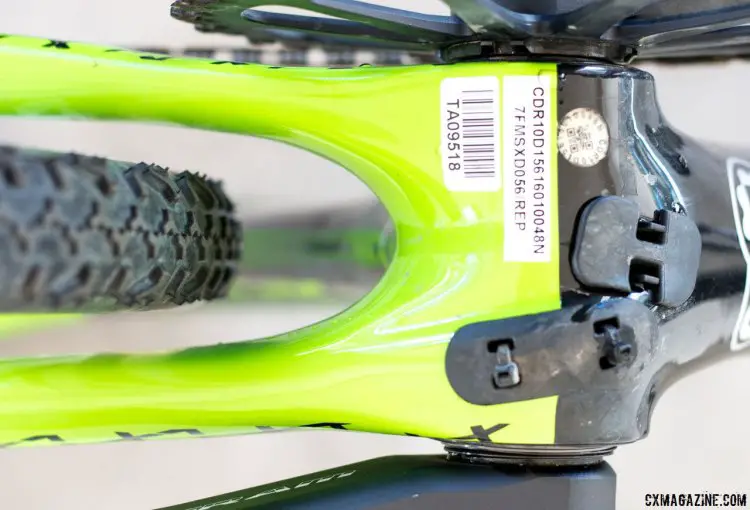
There's tons of clearance around the 33mm tubular for muddy days. 2017 Cannondale SuperX Team Cyclocross bike. © Cyclocross Magazine
With such short chainstays, Cannondale didn’t want to compromise tire clearance, and thus made two frame modifications to increase tire clearance over the prior generation SuperX. First, the contoured seat tube is actually positioned slightly forward over the bottom bracket which added a few mm of clearance in front of the rear tire and behind the bottom bracket. Because of this, the company publishes two seat tube angles, an actual and effective seat tube angle.
More significantly, Cannondale actually moved its entire right drive-side outboard by 6mm. Calling this its Asymmetric Integration (Ai) drivetrain, the chainstays are asymmetrical to increase tire clearance, fitting 40c tires easily. This move requires a standard 142x12mm rear wheel to be redished 6mm to the left. The upside of this change is an evenly dished rear wheel.
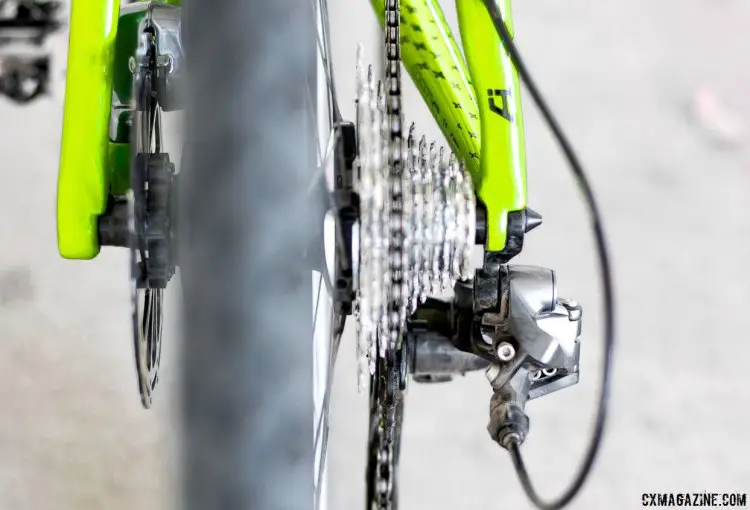
It's hard to see, but the rear wheel has a pretty similar dish on both sides, due to the Ai system. The chainstay, hub and chainline all move out 6mm to the right. 2017 Cannondale SuperX Team Cyclocross bike. © Cyclocross Magazine
The downside of course is that off-the-shelf wheels are not usable on this bike without being redished. It’s a do-once-ride-forever adjustment that experienced mechanics or shops can handle. But it obviously eliminates the ability to share a nice, race-worthy carbon wheel between your other 142x12mm bikes (like your mountain bike) and makes you S.O.L. at your race’s neutral support wheel pit. It’s a less constraining approach to wheel selection than Specialized’s proprietary SCS 135mm thru axle system, but still essentially creates yet another wheel/axle standard.
Riders who pay attention to bike fit should note that the Q-factor of the bike and Si crankset expanded 10mm from 145 to 155mm, to accommodate the 6mm move on the drive side of the bike. This could warrant some minor cleat adjustments if you're coming from a narrower-stance bike. Another note on sizing and fitting is that Cannondale now recommends buyers purchase the same size SuperX as they would in the company's road offerings. This is a change as Cannondale previously advised sizing down when moving from one of the company's road rigs to its 'cross bikes.
More Measured Changes
Those weren’t the only changes Cannondale implemented. Cannondale added the following to its SuperX cyclocross platform:
- 12mm thru axles, front and rear
- Flat mount disc brake caliper mounts
- A 25.4mm seatpost, for better compliance
- A hidden, integrated seatpost binder bolt that allows for 2cm more seatpost extension, for more compliance
- A 1.5” head tube, which can accommodate a Lefty fork
- Internal routing of all cables/wires/housing
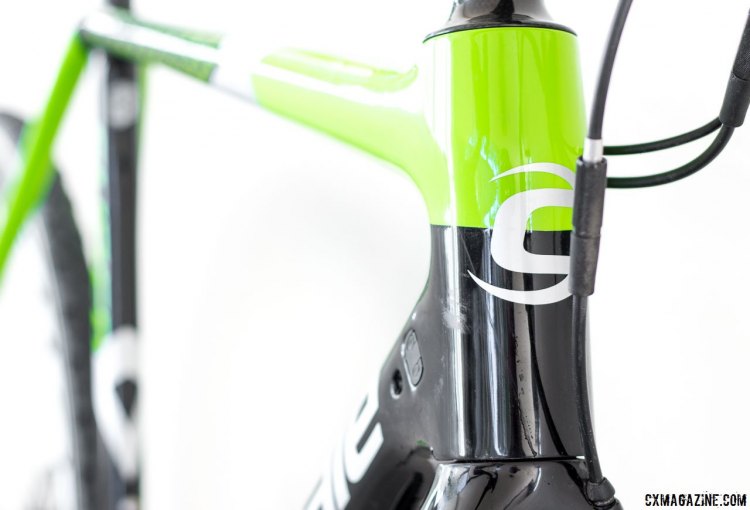
2017 Cannondale SuperX Cyclocross bikes move to a 1.5" head tube that will accept a Lefty fork. © Cyclocross Magazine
Super Fiber Diet
Cannondale didn’t simply add to the SuperX, it also removed quite a bit, in terms of grams. The company’s goal was to return the SuperX back to the benchmark-setting frameset weights it proudly offered when the cantilever-equipped SuperX was unveiled in 2011. Thus with optimized tube shapes and optimized modulus of carbon, the new SuperX frames comes in under 1000 grams, with the full carbon disc fork weighing a scant 390 grams, nearly 200 grams lighter than some competitor’s forks, according to the company.
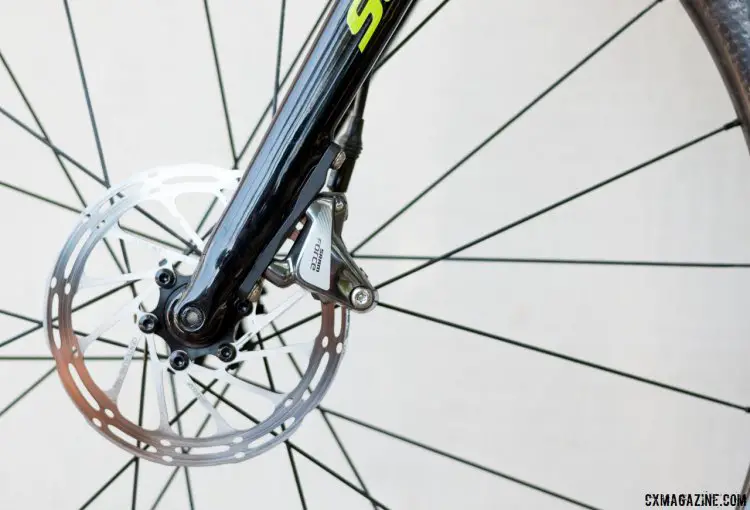
2017 Cannondale SuperX Team Cyclocross bike comes with 140mm rotors front and rear, and the company's gossamer 390g disc fork. © Cyclocross Magazine
Cannondale also removed different modulus options for the new SuperX frame. The new lightweight frameset isn’t just reserved for the top-of-the-line bike and team racers, as every model, including the $2,999 USD Shimano 105-equipped model, gets the lightweight frame.
Raising the Barrier
As is typical with most frame revamps, Cannondale’s SuperX models take a jump up in price, and it's not insignificant. Gone is the price point-busting $1,750 USD Rival-equipped SuperX CX1 model. The Shimano 105 and hydraulic brake-equipped model jumps up into a new category, going from from $1,950 USD to $2,999.99 USD, with a change in spec, as the 2017 model gains tubeless wheels, but gets a downgrade in STI levers and hydraulic brakes, switching from R685 STI levers and RS785 brakes to RS505 models.
At the very top, the SuperX Team we had the pleasure to ride is as race-ready as they come, and doesn’t differ much from the build the Cannondale p/b Cyclocrossworld team will use this season. Dressed with SRAM Force 1 components and top-shelf Zipp 303 tubular disc brake wheels and Challenge Team Edition Baby Limus tires, the $8,499.99 USD SuperX Team is ready to chase World Cup points or your local race’s podiums.
There’s also a new $3,599.99 USD women’s Force-equipped model, which is offered in the three smallest frame sizes and features the same frames, geometry, fork rake, and Outfront Steering Geometry of the men’s models but different componentry in the form of a women’s Fabric saddle and a compact handlebar.
The $5,199.99 USD SuperX Force 1 and $3,499.99 USD SuperX Ultegra models round out the five-bike lineup. The Force 1 model gets Cannondale’s new Hollowgram carbon 35mm deep tubeless wheelset, while the Ultegra model (and women’s model) gets Mavic Aksium wheels, an odd, non-tubeless choice given the Schwalbe X-One tubeless tire spec.
The aluminum CAADX line inherits many of the SuperX changes, including the Outfront Steering Geometry, but does not receive the proprietary Asymmetric Integration chainstay treatment. There are five CAADX models, but three are available in the US:
- CAADX Apex1: $2,060 USD
- CAADX 105: $1,570 USD
- CAADX Tiagra: $1,350 USD
- The CAADX Sora and Ultegra models are sold abroad.
Initial Ride Impressions
We’ve had a new SuperX for two weeks now, and were the first media outlet to receive a test bike and have had two separate testers ride the bike on familiar terrain. Our second tester, Lee Slone, was told nothing about the changes, and avoided reaching for a tape measure in order to test the bike without any preconceived notions.
After a week of riding the bike, he described the ride of the new SuperX as follows:
“Stable is the word I'd use to describe it. At low speeds the steering was light and it was easy to carve around tight corners, but at higher speeds the bike wanted to take a steady line. This was good for mid-corner confidence but it felt like it took a little more effort to pop the bike up and onto alternate lines on the trail when descending. The steering was like a well-tuned power steering system on a sports car—light at parking lot speeds but heavier at speed.”
I myself found the new SuperX to shine brightest on descents, and on a familiar fast, swoopy dirt descent, but without a GPS recording to prove it, I found myself pushing the pace with confidence, and laying off the brakes more than usual. Riding downhill fast was a pure joy on the new SuperX.
On technical trails and turns, I didn’t perceive any major differences in steering, but on steep, rideable run-ups, the front end was a bit easier to pull off the ground—admittedly a pretty rare riding situation. The upside is that with the short chainstays, climbing traction, and rear wheel braking traction, was very good.
The theoretical downside of pushing the front wheel further out is that it’s less weighted, allowing it to slip out in loose or sloppy conditions. With dry, dusty conditions locally, we still didn’t experience any front end washouts, but will be curious to see how this bike performs in slippery muddy corners.
The build spec for our test model leaves little to complain about. Riding Challenge Team Edition tubular tires on Zipp 303 wheels with Force 1 componentry made the bike feel World Championship ready, even if our legs were not. The choice to dress the top-shelf bike with Zipp 303 tubular wheels is an interesting one—there’s little to upgrade if you buy the Team model—but finding and redishing training wheels may be your top priority the day you leave your bike shop.
Evolved, Refined, but Not Perfect
As with any test bike we’ve thrown a leg over, we have a few nitpicks with the SuperX. One is that there is some noisy rattling of the internally-routed housing when you hit the bumps. Another complaint we have is that the seat post has been slipping, something that perhaps a liberal use of carbon paste would solve.
It's also worth noting that the chainstays’ shape and position can also result in a bit of a heel rub for those of us with big feet. I found my size 46 shoe's right heel striking the chainstay from time to time during normal pedaling. It was not nearly as serious of an issue as it was on an early Blue Norcross AL frame we tested, but if you have big feet, and tend to pedal with your heels inward, you might scuff the frame a bit with your shoes without getting creative with cleat positioning or pedal washers.
While Schwalbe’s X-One tubeless tires are spec’d on most SuperX models, we think it’s a miss to not spec tubeless wheels as well. While the Mavic Aksium wheels have brand recognition, a reliable tubeless system should be more useful and valuable for customers who are purchasing the Ultegra and women's Force models.
Our last complaint is more academic in nature. While Cannondale invented the BB30 bottom bracket standard, you could argue that the company's continued loyalty to the format is what necessitates the need to redish the rear wheel on the SuperX. While the 6mm offset required by the Ai stays can arguably result in a stronger wheel, preventing the exchange of wheels between bikes or at a neutral support wheel pit is an inconvenient price to pay when a BB386 EVO or BB86 bottom bracket shell and its 18mm of extra width could eliminate the need for such changes. We’ve seen even better tire clearance on the Bailey/Louis Garneau/Alan trio of BB86 frames and all three accept standard wheels.
At the highest level of cyclocross racing, we think this is a non-issue. Sponsored pros will have dedicated training, racing and pit bikes and wheels. But for the serious amateur, acquiring multiple sets of redished wheels for one bike gets a little more challenging, especially when mountain bikes and road disc bikes have the potential to share one expensive pair of wheels.
Early Verdict
Rattling and wheel compatibility aside, the SuperX thoroughly impresses not only in terms of handling but also versatility. Does big tire clearance and high-speed stability sound appealing for gravel riding? It does to us, and our early impressions put the SuperX high up on our list of bikes to reach for when the call of adventure and gravel racing happens.
"This flagship bike feels extra-competent and has a build that works really well. If I was spending over $8k, I'd want my bike to be able to do it all, all year round, not just during cyclocross season. After testing it with 40c gravel tires, I'm ready to say, this one delivers." -Slone
Our test SuperX Team bike tipped the scales at just 9.46 pounds without wheels, which dips under our previous lightweight disc champ, the Scott Addict, by 0.42 pounds. Total bike weight with Zipp 303 tubular wheels and Challenge Team Edition Baby Limus tubulars? An astonishing 15.72 pounds. Every time you pick up the bike, you feel the difference compared to "average" weight (and priced) bikes. And that difference can be addicting.
Check back soon for our video overview of the Cannondale SuperX cyclocross bike, and see our massive gallery of SuperX Team bike images, bike geometry, and the more affordable models below.
Stay tuned for our full review as we put more time on this lightweight race steed. See our video overview of the 2017 Cannondale SuperX Cyclocross Bike with Cannondale's James Lalonde here.
More info: Cannondale.com
See more cyclocross and gravel news from Bike Press Camp here.













